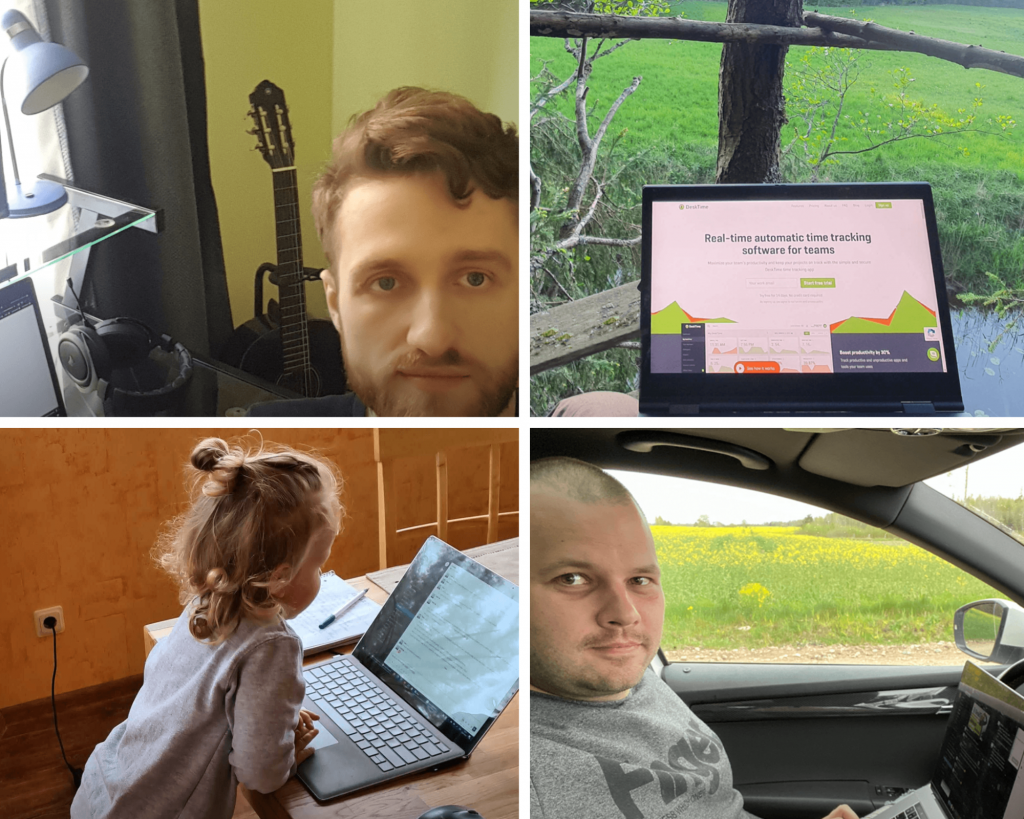How the DeskTime team embraced remote work during a company growth spurt

Only a year ago, remote work was something rarely used within the DeskTime team. Sure, if someone felt under the weather, they could stay and do some work from home, but we usually were all working from the office every day.
Like many companies across the world, DeskTime was confronted by a new reality in spring 2020. In mid-March, the COVID-19 pandemic began, and the first safety measures were announced. On Friday, we were all at work, unaware that this won’t happen again in a long while. Over the weekend, the government decided to close airports and enforce a universal lockdown, so we, too, began working from home.
How did we get used to working remotely? Are we enjoying it? And how did we deal with a major company growth spurt each from the constraints of our home? We’re happy to tell you!
Want to get the most out of your time?
Try DeskTime for free!
Try free for 14 days · No credit card required.
By signing up, you agree to our terms and privacy policy.

How to keep up with company growth remotely
The team was and at the same time wasn’t prepared for the sudden transition to remote work. There was no time to establish processes or rules, no time to experiment and see what works and what doesn’t. Luckily, we had recently improved our internal communication and began using Slack, which allowed us to carry out all communications in one tool.
DeskTime, being a cloud-based solution, enables digital work, and our clients have always been from all around the globe. Also, the DeskTime time tracking tool helps manage and support remote workers, and it was about time for the team behind it to test how it works in practice.
This time coincided with rapid growth in DeskTime registrations and an upsurge in demo requests from clients. “All the team was working overtime, so we had no time to analyze the pros and cons of remote work. All we had to do was work – and see which processes need to be adjusted along the way,” says Toms Blodnieks, Chief Operations Officer at DeskTime.
Soon it became clear that the DeskTime team needed to grow to keep up with the increasing demand. In spring and summer 2020, several new team members joined, which was great but also presented new challenges in remote employee onboarding and engagement. Toms says:
“We are still learning and finding new ways to have quality online time and remote team building activities. We are working hard to engage the colleagues who have joined us during these mostly remote times as we believe they need to feel part of the team more than anybody.”
More DeskTime time
When working from home, the DeskTime team tries to keep things as close to our standard workflow as possible. On Mondays, we hold a longer meeting to discuss all the main tasks and plan the week. On Wednesdays, we have a short follow-up meeting, and on Fridays – smaller meetings for separate teams.
“We quickly got used to virtual meetings and remote communication. We also noticed that there is much more time tracked on the DeskTime app, which makes sense because previously, we could conduct some of our communication face-to-face, by the watercooler or coffee machine. Now, even the smallest details need to be clarified via the computer. Naturally, Slack has become one of the top applications used by our team, as DeskTime data shows us,” says Toms.
DeskTime’s marketing lead Ugis Briedis, who started working with DeskTime last summer, had the chance to meet his new colleagues in person for a few months before the second pandemic wave hit. He says that he feels much more productive at home than at the office:
“I do miss spontaneous conversations with my teammates. However, I believe that the key to successful remote work is a designated “office corner,” where you feel focused and productive.”

Don’t waste time!
Choose smart time management for your team.
Video calls keeping up team spirit
Missing face to face communication is one of the main remote work challenges for the DeskTime team. Office jokes, team building activities, and common outings have always been a part of our company’s culture. We try to tackle this by organizing online meetings, like happy hours and game nights. Even if it’s possible to substitute real-life communication to some extent, it still feels like something’s missing in our daily work life.
For us, video calls have been vital in maintaining a sense of presence. We had switched to calls without video at some point, and everyone could feel the lack of human interaction. Therefore, lately, video calls are an unwritten rule for the DeskTime team.
Another challenge, according to Toms, is maintaining a healthy work-life balance. “It’s easier to overwork at home because you don’t always take as many breaks or a proper lunch break to rest. The computer is always there and it may be tempting to check your email or do some minor tasks after work hours.”
“Something or someone will suffer when you’re working from home. But 99% of the time, it won’t be your work,” laughs Toms.
Other than these two challenges, we are used to working from home and we like it – as demonstrated by yearly employee satisfaction interviews that we recently carried out. It seems that everyone is happy about the remote work setup and how the company supports it. Having a virtual office works great for a team our size, and we feel that all colleagues are just a message or a call away.
Remote work – the new normal for DeskTime
As mentioned earlier, we didn’t do much remote work before spring 2020. However, we’ve always had (and still have) flexible hours where each of us can choose the times of day when we want to work. DeskTime software makes it easy to see our individually most productive hours and count the hours worked at the end of the day, week, or month to see if we’ve done enough hours, or if we haven’t overworked.
“In summer, we could return to the office, but it wasn’t an obligation, and we all decided to stick to remote and flexible work patterns, coming to the office only some days of the week,” Toms explains. “For example, some of us chose to work from our summer cottages or guest houses in different parts of Latvia. We could even travel around, work for a full day and then immediately go sightseeing or to the beach.”

Most importantly, work quality and productivity remain high so there is no reason for us to stop working from home even when the pandemic ends. Meanwhile, those who prefer working from the office are welcome to do so. That said, nobody from the DeskTime team has expressed the wish to return to the office full-time.
“It’s crucial that the team feels trusted and encouraged to work remotely. It fosters self-accountability. And it is our own DeskTime time tracking tool that facilitates such trust and flexibility,” Toms points out.
Virtual parties DeskTime style
For such a social bunch like DeskTime, team building events are vital. Toms says: “In spring, we had no online events because of the huge workload. In summer, when many epidemiological restrictions were lifted, we had two real-life team building events. For Christmas, everyone felt that a common virtual event was necessary.”
Besides discussing the main events and achievements of 2020, we had an online fun & games night that lasted five hours! We each had company-paid dinner delivered to our home. This was the first major virtual event with the participation of our whole team.

Now you know it – we’re not only telling you about remote work in our blog because it’s a trendy topic. We know what we’re talking about because we are living it – and tracking our productivity while we’re at it.
Also, we have started doing webinars about remote work. Interested in joining one? Follow information about the next webinar on the DeskTime Facebook page.
Stay tuned for our Year in Review article coming very soon!
Did you find this article useful? Give it a clap!
Psst! You can clap more than once if you really loved it 🙂